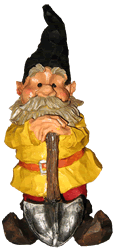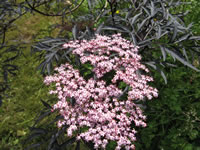Gardening and Landscape Care in the Month of June
Here are a few June gardening tasks and projects that you can do to help keep your garden looking it's best for the rest of this season.
Annuals, Perennials and Bulbs in the Garden
Has your spring been somewhat less than a sunny, gardener's delight? Haven't had enough time to get the garden looking quite right yet? 'Color Spots' may be your quickest and easiest way of catching up with the neighbors.

Color Spots are easy care, blooming size annuals that the nurseries have grown in 4" pots. They have taken care of the feeding, pinching and early care for you. The result is a nicely branched plant, blooming and ready to set in the garden. You will be able to see what your flower will look like before you even pick it out, and have have some early summer colors before the sun sets.
Prepare the soil, water the new plants before you remove them from the pot; plant the color spots at the recommended spacing on the label; water them again.
The Result: I N S T A N T C O L O R !
Pinch your Chrysanthemums to encourage them to be bushier and have more blossoms. Pinch them again, every 6 inches or so, as they grow.
This is an excellent month to pick out a few new perennials, and plant them in the garden. Divide spring flowering perennials like, Primroses, Arabis, and Aubrietia.
Once the soil has warmed, you can sow seeds for perennials directly into the garden.
Check your Roses for mildew, aphid, black-spot or other disease problems or insect infestations, and if they appear take steps to control them right away. Your roses will need to be fertilized each month through the summer. Make sure your climbing roses are securely tied into position. Prune them after blooming.
Deadhead your annuals to encourage continued flowering. Remove dead foliage from your spring flowering bulbs, but only after it has died back naturally.
Sow seeds for Ornamental Kale and Flowering Cabbage for colorful plants next fall and winter.
Stake tall flowers to keep them from blowing over in the wind. Add a stake to each planting hole as you're transplanting, and tie the stem loosely to the stake as the plant grows.
As the weather dries out, your container grown plants may need daily watering especially if the pots are exposed to the drying sunlight.
Gladiola corms can still be planted for successive blooms. Tuberous Begonias can now be safely planted outdoors. Once the foliage of Daffodils has died back, you may divide and move the bulbs to a new spot. Daffodil clusters should be divided up every 3 years to ensure good blooming.
Caring for Shrubs and Trees in the Garden
This is a good month for shearing, pinching or pruning Junipers, Cypress or Conifers. If you've been cultivating a special living Christmas tree, sculpt it now.
Fertilize flowering shrubs like Rhododendrons, Azaleas and Camellias immediately after they have finished flowering with a 'Rhododendron' or 'Evergreen' type fertilizer.
Dead head the developing seed pods from your Rhododendrons and Azaleas to improve next years bloom. Be careful not to damage next years buds which may be hidden just below the pod.
It's hedge sculpting and trimming time!
Fruit and Vegetable Gardening
Start any of the warm weather vegetables (Corn, Beans, Peppers, Egg Plant, Tomatoes, Squash, Pumpkins, etc.) as soon as possible.
Tap your tomato plants to encourage good pollination; water every day and start feeding them weekly once fruits set.
Protect your fruit from the birds with netting.
After natural fruit drop in late June, thin fruits on apple, pear, peach, and apricot trees carefully to produce larger, better fruit. Peach trees need 50 to 75 leaves per fruit to manufacture food for both fruit production and tree maintenance. Apple trees need 30 to 40 leaves per fruit.
Continue thinning your vegetable seedlings to provide ample room for growth.
Mound the soil up around your potato plants. It does no harm to the plant if the soil covers the stem. Tubers near the surface which are exposed to sunlight will turn green and poisonous. As early potatoes begin to die back, reduce watering.
Allow one or two runners to develop from the most productive Strawberry plants.
Plant your Broccoli, Brussels Sprouts, Cabbage, and Cauliflower for next winter's harvest.
Prune suckers and water sprouts from all fruit trees.
Lawn Care
Fertilize the lawn this month.
Use a complete lawn fertilizer with a 3-1-2 ratio of nitrogen, phosphorus, and potassium.
If your lawn suddenly looks yellow or dies out in patches, the cause is probably due to an insect problem such as Crane flies or possibly a disease problem.
If the weather becomes hot and dry raise the cutting height of the mower.
It's not too late to reseed or over-seed the lawn. Be certain to keep newly seeded areas well watered.
Apply moss killers before temperatures reach 65 degrees. Control Dandelions and other lawn weeds.
House Plant Care
House plants can soon be moved outside to a shady, protected spot.
Continue to watch for insect or disease damage and take the necessary steps to control the problem.
Warmer and drier weather means it will be necessary to water and mist your house plants more often. Feed your house plants with 1/2 the recommended strength of a good soluble Houseplant fertilizer.
Odds and Ends Around the Garden
At exactly 12:00 Noon, on June 15th, set your sundial for 12:00 to get the most accurate time reading throughout the summer.
Be alert to slug and snail damage... Seek and destroy ALL slugs!
Keep the weeds pulled, before they have a chance to flower and go to seed again. Otherwise, you will be fighting newly germinated weed seed for the next several years.
Change the water in your bird bath regularly. Standing water may become a breeding ground for mosquito larvae.
Continue to watch for insect or disease damage throughout the garden, and take the necessary steps to control the problem.
